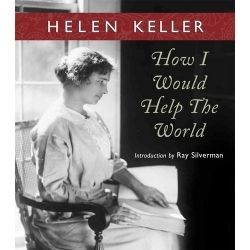How I Would Help the World
Most people are familiar with Helen Keller’s story: She was blind, deaf, and, until the age of ten unable to speak at all. With the guidance of her teacher, Ann Sullivan, she became one of the most remarkable writers and social reformers of her time.
How I Would Help the World, a slim but powerful volume, exemplifies the lasting influence that Helen Keller’s thoughts have had on the world.
Keller was profoundly moved by the revolutionary ideas and writings of Emanuel Swedenborg, a Swedish philosopher and scientist who experienced a spiritual awakening and published his theological opinions in the mid seventeen hundreds. Keller was introduced to Swedenborg’s work by John Hitz, a friend of Alexander Graham Bell. Swedenborg’s Heaven and Hell inspired her to write these words to Hitz: “ … when I remember the truths you have brought within my reach, I am strong again and full of joy. I am no longer deaf and blind; for with my spirit I see the glory of the all-perfect that lies beyond the physical sight and hear the triumphant song of love which transcends the tumult of this world.“
An introduction by Reverend Dr. Ray Silverman, the 2011 Swedenborg scholar-in-residence at Urbana University, explains Swedenborg’s philosophy. He writes that Swedenborg believed all humanity possessed inherent goodness, a concept that clearly inspired Keller. Silverman believes that Keller’s reasons for writing the essays contained within this volume can be found in the introduction that she wrote to Swedenborg’s book True Christian Religion. “Were I but capable of interpreting to others one-half of the stimulating thoughts and noble sentiments that are buried in Swedenborg’s writings, I should help them more than I am ever likely to in any other way. It would be such a joy to me if I might be the instrument of bringing Swedenborg to a world that is spiritually deaf and blind.” Silverman adds that Keller believed that imparting Swedenborg’s message would be her greatest service.
In How I Would Help the World, Keller addresses her own spiritual reawakening via Swedenborg’s writings. In her words: “Religion has been defined as the science of our relations to God and to our fellow men and what we owe to ourselves; and surely Christianity, rightly understood, is the science of love.”
Keller believed, as did Swedenborg, that God was a loving God, not a vengeful one, and that the way to honor God was through service to humanity. In turn, she felt that the way to help the world was to spread the word of Swedenborg. She agreed with the Swede’s view that the second coming of the Lord was not a literal interpretation, but a spiritual manifestation in human beings.
An appendix at the end of the book compares and contrasts Keller’s religious viewpoints with those of Swedenborg and photographs of Keller in various stages of her life are sprinkled throughout the book.
How I Would Help the World showcases Keller’s extraordinary intelligence, her compassion, her thirst for knowledge, and her remarkable ability to see without sight. As she is so eloquently quoted in Silverman’s introduction, “The only thing worse than being blind is having sight but no vision.”
Reviewed by
Hilary Daninhirsch
Disclosure: This article is not an endorsement, but a review. The publisher of this book provided free copies of the book and paid a small fee to have their book reviewed by a professional reviewer. Foreword Reviews and Clarion Reviews make no guarantee that the publisher will receive a positive review. Foreword Magazine, Inc. is disclosing this in accordance with the Federal Trade Commission’s 16 CFR, Part 255.

